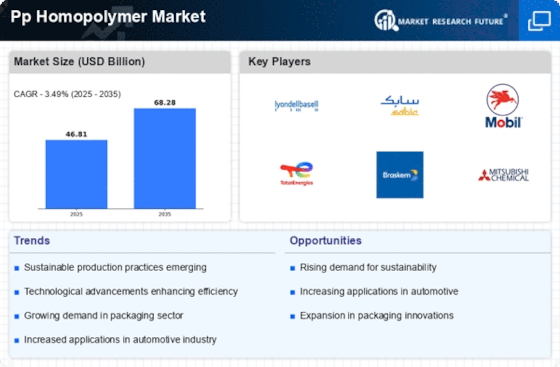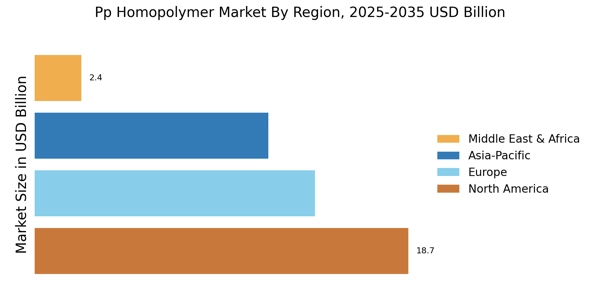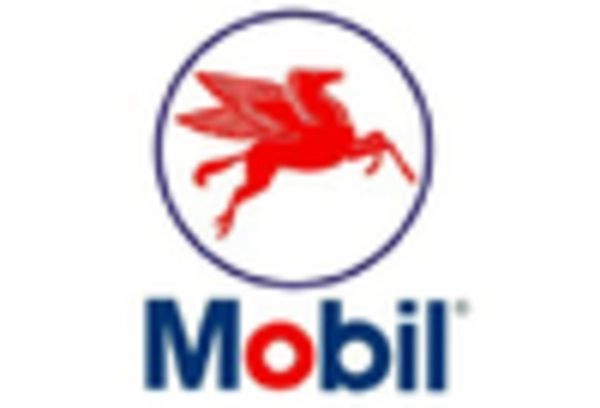Sustainability Initiatives
The Pp Homopolymer Market is increasingly influenced by sustainability initiatives. As environmental concerns gain prominence, manufacturers are compelled to adopt eco-friendly practices. This shift is evident in the rising demand for recyclable and biodegradable materials. The industry is witnessing a surge in the development of sustainable polypropylene homopolymers, which are designed to minimize environmental impact. Furthermore, regulatory frameworks are evolving to support sustainable production methods, thereby encouraging investment in green technologies. The market is projected to grow as consumers increasingly prefer products that align with their environmental values. This trend not only enhances brand reputation but also opens new avenues for innovation within the Pp Homopolymer Market.
Technological Advancements
Technological advancements play a pivotal role in shaping the Pp Homopolymer Market. Innovations in polymerization processes and material formulations are enhancing the performance characteristics of polypropylene homopolymers. For instance, the introduction of advanced catalysts has led to the production of high-performance grades with improved mechanical properties. This has resulted in a broader application range, particularly in sectors such as packaging and automotive. The market is also benefiting from automation and digitalization, which streamline production processes and reduce costs. As technology continues to evolve, it is likely to drive efficiency and sustainability in the Pp Homopolymer Market, fostering competitive advantages for early adopters.
Growth in Packaging Applications
The Pp Homopolymer Market is experiencing robust growth driven by the expanding packaging applications. Polypropylene homopolymers are favored for their excellent clarity, moisture resistance, and durability, making them suitable for food packaging, consumer goods, and industrial applications. The increasing consumer preference for convenient and sustainable packaging solutions is propelling demand. Moreover, the rise of e-commerce has led to a surge in packaging requirements, further stimulating the market. As companies strive to enhance product shelf life and reduce waste, the Pp Homopolymer Market is likely to witness continued expansion, supported by innovations in packaging technologies.
Rising Demand in Automotive Sector
The automotive sector is a significant driver for the Pp Homopolymer Market. With the increasing focus on lightweight materials to enhance fuel efficiency, polypropylene homopolymers are gaining traction. Their favorable properties, such as high strength-to-weight ratio and resistance to chemicals, make them ideal for various automotive applications, including interior components and exterior parts. The market is projected to expand as automotive manufacturers seek to comply with stringent emissions regulations while improving vehicle performance. Additionally, the trend towards electric vehicles is likely to further boost demand for lightweight materials, positioning the Pp Homopolymer Market favorably for future growth.
Increasing Use in Construction Sector
The construction sector is emerging as a vital driver for the Pp Homopolymer Market. Polypropylene homopolymers are increasingly utilized in various applications, including pipes, insulation, and flooring materials, due to their durability and resistance to environmental stressors. The ongoing urbanization and infrastructure development projects are expected to bolster demand for these materials. Additionally, the trend towards energy-efficient building solutions is likely to enhance the appeal of polypropylene homopolymers, as they contribute to improved thermal insulation and reduced energy consumption. This growing adoption in construction applications positions the Pp Homopolymer Market for sustained growth in the coming years.


















Leave a Comment